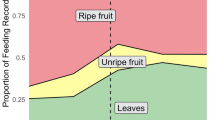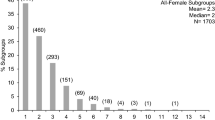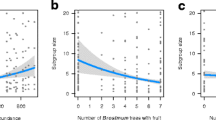Abstract
Recent research on the ecology and behavior of free-ranging spider monkeys (Ateles paniscus chamek) allows a more detailed comparison with the chimpanzee,Pan troglodytes, than has been possible previously. Despite their distant common ancestry, chimpanzees and spider monkeys share an unusual fission-fusion social system. In this paper, I compare subgroup size and composition, social unit structure, ranging behavior, patterns of philopatry and dispersal, and social relationships in the two taxa. It is proposed that spatial and temporal patchiness in food dispersion and abundance, resulting in a high-level of feeding competition between females within a group, has been the most important ecological selection pressure leading to the evolution of fission-fusion social organization in both species.
Similar content being viewed by others
References
Badrian, A., and Badrian, N. (1984). Social organization ofPan paniscus in the Lomako Forest, Zaïre. In Susman, R. L. (ed.),Evolutionary Morphology and Behavior of the Pygmy Chimpanzee, Plenum Press, New York.
Bauer, H. R. (1987).Ethological Aspects of Gombe Chimpanzee Aggregations with Implications for Hominisation. Ph.D. thesis, Stanford University.
Cant, J. G. H. (1977).Ecology, Locomotion, and Social Organization of Spider Monkeys (Ateles belzebuth). Ph.D. thesis, University of California, Davis.
Cluton-Brock, T. H. (1974). Primate social organisation and ecology.Nature (Lond.)250: 539–542.
Crook, J. H., and Gartlan, J. S. (1966). Evolution of primate societies.Nature (Lond.) 210: 1200–1203
Eisenberg, J. F., Muckenhirn, N. A., and Rudran, R. (1972). The relationship between ecology and social structure in primates.Science 176: 863–874.
Gautier-Hion, A. (1980). Seasonal variations of diet related to species and sex in a community ofCercopithecus monkeys.J. Anim. Ecol. 49: 237–269.
Ghiglieri, M. P. (1984).The Chimpanzees of Kibale Forest: A Field Study of Ecology and Social Structure, Columbia University Press, New York.
Goodall, J. (1983). Population dynamics during a fifteen-year period in one community of freeliving chimpanzees in the Gombe National Park, Tanzania.Z. Tierpsychol. 61: 1–60.
Goodall, J. (1986).The Chimpanzees of Gombe, Belknap Press, Cambridge, Massachusetts.
Goodall, J., Bandora, A., Bergmann, E., Busse, C., Matama, H., Mpongo, E., Pierce, E., and Riss, D. (1979). Intercommunity interactions in the chimpanzee population of the Gombe National Park. In Hamburg, D. A., and McCown, E. R. (eds.),The Great Apes, Benjamin/Cummings, Menlo Park.
Halperin, S. D. (1979). Temporary association patterns in free-ranging chimpanzees: An assessment of individual grouping preferences. In: Hamburg, D. A., and McCown, E. R. (eds.),The Great Apes, Benjamin/Cummings, Menlo Park.
Harrison, M. J. S. (1983). Age and sex differences in the diet and feeding strategies of the green monkey,Cercopithecus sabaeus.Anim. Behav. 31: 969–977.
Hasegawa, T., and Hiraiwa-Hasegawa, M. (1983). Opportunistic and restrictive matings among wild chimpanzees in Mahale Mountains, Tanzania.J. Ethol. 1: 75–85.
Hiraiwa-Hasegawa, M., Hasegawa, T., and Nishida, T. (1984). Demographic study of a largesized unit-group of chimpanzees in the Mahale Mountains, Tanzania.Primates 25(4): 401–413.
Jolly, A. (1972).The Evolution of Primate Behavior, Chicago University Press, Chicago.
Klein, L. L. (1972).The Ecology and Social Organization of the Spider Monkey, Ateles belzebuth. Ph.D. thesis, University of California, Berkeley.
Klein, L. L., and Klein, D. J. (1977). Feeding behaviour of the Columbian spider monkey. In Clutton-Brock, T. H. (ed.),Primate Ecology: Studies of Feeding and Ranging Behavior in Lemurs, Monkeys, and Apes, Academic Press, New York.
Napier, J. R., and Napier, P. H. (1985).The Natural History of the Primates, MIT Press, Cambridge, MA.
Nishida, T. (1968). The social group of wild chimpanzees in the Mahali Mountains.Primates 9: 167–224.
Nishida, T. (1974). Ecology of wild chimpanzees. In Ohtsuka, T., and Nishida, T. (eds.),Human Ecology, Kyoritsu-Shuppan, Tokyo. (In Japanese).
Nishida, T. (1979). The social structure of chimpanzees of the Mahale Mountains. In Hamburg, D. A., and McCown, E. R. (eds.),The Great Apes, Benjamin/Cummings, Menlo Park.
Nishida, T., Hiraiwa-Hasegawa, M., Hasegawa, T., and Takahata, Y. (1985). Group extinction and female transfer in wild chimpanzees in the Mahale Mountains.Z. Tierpsychol. 67: 284–301.
Pulliam, H. R., and Caraco, T. (1984). Liying in groups: Is there an optimal group size? In Krebs, J. R. and Davies, N. B. (eds.),Behavioural Ecology, 2nd Ed., Blackwell, Oxford.
Richard, A. (1974). Intraspecific variation in the social organization and ecology ofPropithecus verreauxi.Folia Primatol. 22: 178–207.
Roosmalen, M. G. M. van (1980).Habitat Preferences, Diet, Feeding Strategy, and Social Organization of the Black Spider Monkey (Ateles paniscus paniscus) in Surinam. Unpublished doctoral dissertation, University of Wageningen, Netherlands.
Struhsaker, T. T. (1969). Correlates of ecology and social organization among the African cercopithecines.Folia Primatol. 11: 80–118.
Sugiyama, Y. (1973). The social structure of wild chimpanzees: A review of field studies. In Michael, R. P., and Crook, J. H. (eds.),Comparative Ecology and Behavior of Primates, Academic Press, London.
Sussman, R. W. (1977). Feeding behavior ofLemur catta andLemur fulvus.In Clutton-Brock, T. H. (ed.),Primate Ecology: Studies of Feeding and Ranging Behavior in Lemurs, Monkeys, and Apes, Academic Press, New York.
Symington, M. M. (1987a).Ecological and Social Correlates of Party Size in the Black Spider Monkey, Ateles paniscus chamek, Ph.D. thesis, Princeton University.
Symington, M. M. (1987b). Sex ratio and maternal rank in wild spider monkeys: When daughters disperse.Behav. Ecol. Sociobiol., 20: 421–425.
Symington, M. M. (1988a). Food competition and foraging party size in the black spider monkey (Ateles paniscus chamek).Behaviour 105(1–2): 117–134.
Symington, M. M. (1988b). Demograpny, ranging patterns and activity budgets of black spider monkeys (Ateles paniscus chamek) in the Manu National Park, Peru.Am. J. Primatol. 15:45–67.
Symington, M. M. In press. Environmental determinants of population densities inAteles. Primate Conservation.
Terborgh, J. (1983).Five New World Primates: A Study in Comparative Ecology, Princeton University Press, Princeton.
Tutin, C. E. G. (1979). Mating patterns and reproductive strategies in a community of wild chimpanzees (Pan troglodytes schweinfurthii).Behav. Ecol. Sociobiol. 6: 29–38.
Waser, P. M., and Homewood, K. (1979). Cost-benefit approaches to territoriality: A test with forest primates.Behav. Ecol. Sociobiol. 6: 115–119.
White, F. (1987).Ecology and Behavior of the Pygmy Chimpanzee, Pan paniscus. Ph.D. thesis, State University of New York, Stony Brook.
Wrangham, R. W. (1975).The Behavioural Ecology of Chimpanzees in the Gombe National Park, Tanzania. Ph.D. thesis, Cambridge University.
Wrangham, R. W. (1977). Feeding behaviour of chimpanzees in Gombe National Park, Tanzania. In Clutton-Brock, T. H. (ed.),Primate Ecology: Studies of Feeding and Ranging Behavior in Lemurs, Monkeys, and Apes, Academic Press, New York.
Wrangham, R. W. (1979). On the evolution of ape social systems.Soc. Sci. Inf. 18(3): 335–368.
Wrangham, R. W. (1980). An ecological model of female-bonded primate groups.Behaviour 75(3–4):262–300.
Wrangham, R. W. (1986). Ecology and social relationships in two species of chimpanzees. In Rubenstein, D. I., and Wrangham, R. W. (eds.),Ecological Aspects of Social Evolution: Birds and Mammals, Princeton University Press, Princeton, New Jersey.
Wrangham, R. W., and Rubenstein, D. I.(1986). Social evolution in birds and mammals. In Rubenstein, D. I., and Wrangham, R. W. (eds.),Ecological Aspects of Social Evolution: Birds and Mammals, Princeton University Press, Princeton, New Jersey.
Wrangham, R. W., and Smuts, B. B. (1980). Sex differences in the behavioural ecology of chimpanzees in the Gombe National Park, Tanzania.J. Reprod. Fertil., Suppl. 28: 13–31.
Author information
Authors and Affiliations
Rights and permissions
About this article
Cite this article
Symington, M.M. Fission-fusion social organization inAteles andPan . International Journal of Primatology 11, 47–61 (1990). https://doi.org/10.1007/BF02193695
Received:
Revised:
Issue Date:
DOI: https://doi.org/10.1007/BF02193695




